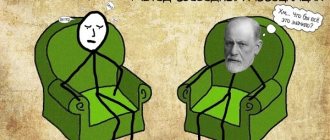Greetings, friends. Imagine a dog. Introduced? Great, then everything is fine with your imagination! Just some of you presented the dog in general terms, while others presented something special, with a name and character. The fact is that everyone's imagination is developed differently. Its deficiency can become a stumbling block on the path of personal development or career growth. In this article we will talk about how to develop imagination and fantasy in order to learn to think creatively and generate new ideas.
What is fantasy?
Fantasy is a product of the imagination, characterized by special strength, brightness, spontaneity and uniqueness of the created symbols, paintings or images. This is a superconcentration of ideas that stimulates knowledge, awakens a keen interest in everything around us and a desire to explore it all. Accordingly, the ability to fantasize is the ability to create in one’s imagination something new, implausible, unprecedented, impossible or inconsistent with reality. Fortunately, the storehouse of imagination is inexhaustible.
Without fantasies, it would be difficult for a person to get along with reality or create it. After all, everything that surrounds us is the result of someone’s invention, embodied in materials, buildings, household appliances, transport, the Internet, books, paintings - in everything. Fantasy as a personality quality is necessary in any process, but in creativity it is irreplaceable. Therefore, artists, writers, photographers, designers, dancers, and stylists carefully cherish this ability. But more often they call it creativity.
But the ability to fantasize is useful not only for creative people. Fantasies, slips of the tongue, free associations, erroneous actions - all this is a direct road to the unconscious. And the unconscious is the object of psychological research. It’s not for nothing that Sigmund Freud called fantasies “the façade of dreams,” which reflect hidden thoughts, secret desires, and unfulfilled intentions. True, he reminded us that it is necessary to distinguish them from reality.
And here lies the ambiguous benefits of fantasy. On the one hand, the development of fantasy enhances the ability to create, extend, and double reality. But on the other hand, this is a way to get away from it. Sometimes fantasies become a way of life, and somehow imperceptibly replace a significant part of it. And here you need to be careful.
Take the brain hemisphere test
Books for developing imagination
- "Steal Like an Artist" by Austin Kleon
- "Six Thinking Hats" by Edward De Bono
- "Genius to Order" by Mark Levy
- "Rice Storm and 21 More Ways to Think Outside the Box" by Michael Micalko
- “Hacking Creativity: How to See What Others Can’t See,” Michael Mikalko
- “Learn to see. Lessons from creative upswings”, Marina Moskvina
- "The Flexible Mind" by Estanislao Bachrach
- “How people think”, Dmitry Chernyshev
- "Skits on Sundays", Christoph Niemann
- “Brain 100%. Intelligence. Memory. Creative. Intuition.”, O. Kinyakina, O. Ovchinnikova, P. Lem, T. I. Zakharova, Y. Asoskova
What kind of fantasies are there?
Fantasy is such a broad topic that it is impossible to consider it from all angles at one time. Let's talk about the most popular ones.
Unconscious.
Sometimes you can hear the reproach addressed to someone: “You are completely devoid of imagination.” In fact, there are no people who are incapable of fantasizing. Fantasies just arise unconsciously. In Freud's psychoanalysis they are explained by two schemes: a) they were originally formed in the unconscious; b) were formed in consciousness, but fell into the unconscious due to repression.
- Pros. This key concept of psychoanalytic theory will help you learn a lot about yourself.
- Minuses. Left unattended, they can provoke mental and psychosomatic disorders.
Children's.
Children's imagination actively develops from the age of 3-3.5 years and has no boundaries. Children come up with imaginary friends, plots for games, new stories for their favorite characters from books or cartoons. This is how they explore the world, learn correct behavior and communication in the real world, build psychological defense, and open up creatively.
- Pros. Imagination aimed at creativity helps to reveal uniqueness and talent, relax and just have fun.
- Minuses. If a child is not taught the difference between a fantasy and a lie, he may grow up to be a pathological liar.
Scientific.
Innovation is not just a flight of fancy. This is a revolution that makes it possible to move beyond the right answers and find a truly new solution. Through a combination of imagination and scientific thinking, robotic surgeons have emerged. cellular communications, bioprosthetics, artificial intelligence, flexible smartphones, 3D printing and virtual reality.
- Pros. In the world of innovation and creativity, new trends are expected - techno-cities of the future, invulnerable quantum computers, 4D and 5D printing, learning robots, a new generation of unmanned vehicles.
Writing.
The depth of the writer's imagination allows the reader to travel in time and space, penetrate into the artistic world of the characters, and observe exciting events of the past and future. Books bring so many wonderful things, knowledge, emotions, advice, adventures into the lives of readers that one can only rejoice at such a rich imagination.
- Pros. Reading is precisely the form of relaxation that brings the greatest feeling of happiness and satisfaction with life.
Erotic.
Sexologists have this joke: 90% of people indulge in sexual fantasies, and the remaining 10% simply do not admit it. A night with an ex-partner, sex with a celebrity or a stranger, sexual games in nature or in an unfamiliar place - such erotic dreams help to “complete” a not very happy picture of reality.
- Pros. Active fantasizing about sex helps to weaken internal inhibitions, express and realize repressed desires.
- Minuses. Too realistic and unfulfilled erotic fantasies can lead to sexual perversion. They also have a relationship-destroying effect. Especially if partners try to implement them on the side.
Take the Freud test
Neurotic.
The frightening fantasies of a neurotic provoke fears about an imaginary future. This could be an exaggerated fear of death, fears about the fall of a comet or a house, fear of an incurable disease, or perversely obsessive desires. All of them have no basis here-and-now, but cause considerable discomfort to the neurotic.
- Minuses. Suffering, emotional instability, uncertainty are part of the personality of a neurotic. Obsession with one’s terrible illusions poisons the life of the neurotic himself and everyone who is nearby.
Fantasy as a creative process
⇐ PreviousPage 3 of 5Next ⇒Fantasy - (Greek - imagination) - a situation imagined by an individual or group that does not correspond to reality, but expresses their desires; an unreal combination of real elements; a dream, a product of the imagination. Fantasies can be of any nature.
There are active and passive fantasies; the former are caused by intuition, that is, an attitude aimed at the perception of unconscious contents, and libido immediately occupies all elements emerging from the unconscious and brings them, through the association of parallel materials, to complete clarity and visibility; passive fantasies appear immediately in a visual form, without a preceding or accompanying intuitive attitude, with a completely passive attitude of the cognizing subject. Such fantasies belong to mental “automatisms”. Passive fantasy always arises from some process in the unconscious; active fantasy owes its existence to the participation of consciousness.
With the help of fantasy, a person can get used not only to the images of other people, but also to any images of objects and phenomena, transforming their nature. These can be images of living beings, then a person endows them with human traits, personifies them. This is what a fabulist does, for example. If objects are images of inanimate objects, then fantasy can give them the appearance of animate beings.
The very nature of creative activity, which reveals something new and unknown, presupposes the desire to look into the future and anticipate the result of the activity. This is what fantasy does, performing a prognostic function. The motives of fantasy, in principle, coincide with the motives of creative activity. First of all, this is the need for search activity, the desire for novelty, the unusual, the unpredictable. Another motive for fantasy is often unsatisfied desires of various kinds. The motive of self-expression, the desire to assert one’s personality, is also essential.
Creative imagination is original, independent, active and purposeful. Other types of fantasy - dreams, daydreams, recreating fantasy (according to the description) are characterized by passivity and whimsicality. This is, for example, the fantasy of viewers and listeners of a work of art.
When imagining, the child himself creates any plot he wants, including a fairy tale, any situation he wants, any problem he wants, and solves it himself in any way he wants. Any solution is acceptable. And when solving real problems, the child is looking not for any solution, but for a real, “adult”, serious, feasible solution. In both cases, he creates, but with fantasy there is more freedom, since there are no prohibitions from physical laws and much knowledge is not required. But the main thing is not to “overdo it” with fantasy, so that fantasy does not become stupidity. Stupidity is an unnecessary, unreasonable, incorrect, harmful, inappropriate act or statement that does not bring honor to the one who committed it. Of course, one must take into account the person’s age, conditions and goals of the act.
The classic vehicle of fantasy is the fairy tale. What is the difference between a fairy tale and science fiction? In science fiction, technically feasible situations, elements or processes are considered, and in a fairy tale, any. It should be noted that there is also no sharp boundary between fantastic and real solutions. For example, what was considered fantasy in the time of Jules Verne is now everyday reality. G.A. Altshuller calculated that out of 108(!) ideas and forecasts of J. Verne, 99 (90%) were implemented. Herbert Wells has 77 out of 86, Alexander Belyaev has 47 out of 50 [Altshuller G.S. Human life 1-4-502 // TRIZ Magazine. -1996. — No. 2. — p.44-52; 1997. - N1. - p.4-15].
When a child selflessly tells fables with his own participation, he is not lying; in our usual understanding, he is composing. It doesn't matter to him whether it's real or not real. And this shouldn’t be important to us, what’s important is that the child’s brain works and generates ideas. However, you should still pay attention to what the child dreams of. If he talks all the time about his non-existent friends, about affectionate parents or about toys, then perhaps he suffers, dreams about it and thus pours out his soul.
Conclusion: fantasy is a situation that does not correspond to reality, invented, fictitious.
Characteristics of imagination
Imagination is a special form of human life, standing apart from other technical processes and at the same time occupying an intermediate position between perception, thinking and memory.
Imagination is a special form of reflection, which consists of creating new images and ideas by processing existing ideas and concepts. The development of imagination follows the lines of improving the operations of replacing real objects with imaginary ones and recreating imagination. The child gradually begins to create, based on existing descriptions and texts, increasingly complex images and their systems. The content of these images develops and enriches. Imagination becomes mediated and intentional.
In human life, imagination performs a number of specific functions. A.S. Vygotsky identifies three functions of imagination [Vygotsky L.S. Selected psychological studies. – M., 1966]:
1. Consistent. In order to evoke in a child a vivid idea of an object, it is necessary to find in real life all the elements from which the idea will be built.
2. Emotional. Every emotion has its own internal and external state, which means that fantasy is an apparatus that directly carries out the work of our emotions.
3. Educational. In play, the emotional function allows us to ensure the organization of environmental forms that allow us to develop and exercise our abilities. It can be noted that all the functions of the imagination are entirely consistent with its psychological property - behavior aimed at forms, which has not yet been in our work, and this emphasizes the need for the development of imagination.
Imagination is characteristically associated with the activity of the entire organism, being at the same time the most “mental” of all mental processes and states. The ideal and mysterious character of the psyche is not manifested in anything other than the imagination. Thanks to imagination, a person creates, intelligently plans and manages his activities. Almost all human material and spiritual culture is a product of people's imagination and creativity. Imagination takes a person beyond the limits of his momentary existence, reminds him of the past, opens up the future. Possessing a rich imagination, a person can “live” in different times.
Imagination is the mental process of creating images of objects and situations by bringing a person’s existing knowledge into a new combination.
Thanks to imagination, a person creates, intelligently plans and manages his activities. Almost all human material and spiritual culture is a product of people's imagination and creativity. Imagination takes a person beyond the limits of his momentary existence, reminds him of the past, opens up the future. Possessing a rich imagination, a person can “live” in different times, which no other living creature in the world can afford.
Imagination differs from perception in that images do not always correspond to reality; they contain elements of fantasy, if imagination draws to consciousness pictures that nothing or little corresponds to. In fact, it is called fantasy. If, in addition, the imagination is aimed at the future, it is called a dream.
Imaginations are: involuntary or passive: dreams, reveries, hallucinations (auditory and visual); voluntary or active imagination: recreative or reproductive and creative, musical. Creativity includes dream and fantasy.
Active imagination is characterized by the fact that, using it, a person, at his own request, by an effort of will, evokes appropriate images in himself. Active imagination includes creative and musical imagination.
Creative imagination is a type of imagination in which a person independently creates new images and ideas that are valuable to other people or society as a whole and which are embodied (“crystallized”) into specific original products of activity. Images of the creative imagination are created through various techniques and intellectual operations. In the structure of creative imagination, two types of such intellectual operations are distinguished:
1st type of operations through which ideological images are formed;
2nd type of operations, on the basis of which finished products are processed.
Images of passive imagination arise spontaneously, regardless of the will and desire of a person. Productive imagination is distinguished by the fact that in it reality is conscious, constructed by man, and not simply mechanically cooperated by him, recreated, but at the same time it is still creatively transformed in the image. In reproductive imagination, the task is to reproduce reality as it exists, and although there is also an element of fantasy, such imagination is more reminiscent of perception or memory than creativity.
Dreams can be classified as passive and involuntary forms of imagination. Their true role in human life has not yet been established, although it is known that in human dreams many vital needs find expression and satisfaction, which, for a number of reasons, cannot be realized (realized) in life.
Hallucinations are actual visions that apparently have almost no connection with the reality around a person. Usually they are the result of certain mental disorders or the functioning of the body that accompany many painful conditions.
Dreams, unlike hallucinations, are a completely normal mental state, representing a fantasy associated with a desire, most often a somewhat idealized (imagining) future.
A dream differs from dreams in that it is somewhat more realistic and more connected with reality, that is, in principle, feasible. Dreams and daydreams occupy a fairly large part of a person's time, especially in youth. For most people, dreams are pleasant thoughts about the future. Some also experience disturbing visions that generate feelings of anxiety, guilt, and aggressiveness.
Conclusion: thanks to their imagination, students can create images of objects that correspond to reality, and imagine the characters of a literary work.
creative thinking imagination literature
⇐ Previous3Next ⇒
Didn't find what you were looking for? Use Google search on the site:
What is escapism?
Escapism is a synonym for the concept of “escape,” no matter where: to work, sex, art, healthy lifestyle, religion, to remote villages, to monasteries, to communication on forums, games, intoxication or psychotropic substances. Against the background of such “hobbies,” escaping into a fantasy world looks harmless. But this is at first glance.
The world invented by a fantasy mind looks more attractive than reality . It is he who saves the psyche from destruction. But gradually such “mind games” replace the real world with a fictional one. Along with the weakening of the boundary between illusion and reality, self-control is lost, the sense of responsibility for one’s life, the desire to correct something, to achieve something goes away. This can lead to deterioration, slide into psychosis, or provoke a personality disorder. And this is already a diagnosis.
What to do in such a situation? Step back and look at her from the side. In fact, a manufactured illusion becomes a powerful driving force only if it motivates action. It is important to distinguish between different forms of fantasies:
- Sweet dreams are akin to “rose-colored glasses” in which there is no room for reality - this is an unkind sign.
- Fantasy, which enhances energy and moves forward, is useful.
There is another secret: turning fantasy into reality is much more exciting than just fantasizing about nothing.
Bottom line
If you enter “How to develop imagination and fantasy” into the search engine, you can find all sorts of games that develop imagination and various exercises. But I believe that the imagination should work constantly, and not just 5 minutes a day. Therefore, the tips I have chosen are suitable for everyday use and will allow you to use your imagination as often as possible.
There is also an interesting topic - how to develop fantasy and imagination in a child. I will write about this in another article. Subscribe so you don't miss a publication.
Friends, write in the comments your ways to develop imagination and fantasy. Perhaps I will supplement the article with new options.
And write which dog you presented :)
Until we meet again, yours, Alexander Gorokhov.
HOW TO EXPLAIN THE UNEXPLAINABLE
Since childhood (from the childhood of humanity and from our personal childhood), we have to somehow correct this unsatisfactory situation. Haeckel’s law, disliked by modern biology (“ontogenesis is a brief repetition of phylogeny”), seems to be playing out here, on a foreign site, in full force. Our ancestors easily turned unknown and inexplicable things and phenomena into funny, scary, friendly or dangerous, but always outlandish entities.
They did this, undoubtedly, in the interests of the integrity of the observed world and the preservation of cause-and-effect relationships in it. Thunder rumbles because Elijah the prophet is riding in a chariot. In the forest, a goblin confuses the paths, Baba Yaga flew across the sky with a lantern in a mortar, a drowned man was dragged away by a mermaid, and kikimoras braided the horse’s mane...
Our children are doing exactly the same thing today. “Who's knocking there? “Babai lives behind the wall.” “Why is the curtain swaying so strangely? “There’s a ghost standing there.” An explosive mixture of primitive explanations and sweet metaphysical horror, just like our ancestors. Sometimes, in its pure form, it is the fruit of an uncomplicated child’s imagination.
From my practice. A five-year-old child asked: “Why do they smear iodine on a scratch?” They answered him: “To kill germs.” And they didn’t explain anything else. “Why does iodine sting? - thought the child. - After all, if you wash it with water, it won’t hurt. Yeah! (A consistent fantasy picture began to form.) Water does not kill microbes, but iodine kills them. Microbes are something living (since they die), such very small harmful animals. And so, when they die, they, in their final anger, cling to your hand with their little teeth. That’s why it hurts (the picture was completed).”
What are men silent about?2
Most often, a man imagines something that is impossible to achieve in life with his real sexual partner.
- Threesome
The most popular fantasy, which excites 64% of respondents. Participants most often: him and two girls. The character can be a lover, her friend, or a casual acquaintance. Less often it is one girl and two guys. Group love is preferred by a third of men; the number of partners can be innumerable.
In practice, such experiences often lead to the breakdown of relationships. After all, if a third appears in the most intimate, then the exclusive closeness between partners disappears. Sex has so much variety, so try a different option.
- Spontaneity
Guys fantasize about unexpected sex with a stranger, regardless of whether they have a regular partner. Thoughts come suddenly, having met a sexy person right on the street. And the man imagines himself coming up and... continuing to move on.
Even if such an opportunity is presented, it is rare for a guy to carry out such reckless acts. Psychologists are confident that every man, sooner or later, fantasizes about daring, passionate sex with Lady X.
- Voyeurism
A common fantasy among representatives of the stronger half. According to surveys, more than 70% of respondents do not mind seeing something spicy. Vuyerism is attractive because the object of desire is unaware of the surveillance. A man is very interested in how others have sex, he wants to see something like in a porn film. It is important to remain unnoticed. Voyeurism excites 3 out of 4 men.
Special clubs even provide a service - peep show. A naked girl dances behind the mirror, who does not see the client, but he sees her and gets a lot of pleasure. Often married couples come to spy on them, who in this way want to introduce novelty and thrills into their sex life.
- BDSM
Hard sex is to the liking of every 3 men. He sees a mistress in front of him in a tight leather outfit with a whip (a mandatory element). Leaders often desire submission; strict bosses dream of submitting to a woman.
- Girl of unusual appearance
Everyone has their own idea about non-standard girls. This could be an African-American woman, overweight, elderly, a woman with a lot of tattoos or with an unusual hair color. The stronger sex has an assumption that the girl is not like everyone else and has incredible skills. Just look at the jokes about the unusual anatomical structure of the intimate parts of Asian women. There is only one way to check a myth - to see for yourself.
- Out of range
Yes, men also dream of unattainable women, including actresses, singers, friends of friends, bosses, and colleagues. In general, anyone except his partner. The further away the desired person is, the more the excitement increases. Sometimes it can be a fictitious girl, a combination of several acquaintances. Such desires are characteristic of half of the male population.
- Forced sex
A popular idea among men that differs in its degree of cruelty. Here you can give free rein to your imagination, since the guy can afford everything, the scenario depends on the level of perversity. But only 1 in 6 men are able to admit their true desires.
There is a high probability that there are many more people who want to take possession of a girl against her will, since this type of behavior was characteristic of ancient people. Some men, on the contrary, want to be raped. More often they dream of proactive partners.
This is interesting. The most extreme male sexual fantasy, embodied in reality, is recorded by the Guinness Book of Records in Japan. Prostitutes provide sampan service. They have sex in a pond on a boat, while the woman bends overboard, her head in the water. The man takes her from behind. When she chokes and loses consciousness, the vaginal muscles spasm, and the client feels incredible sensations.











